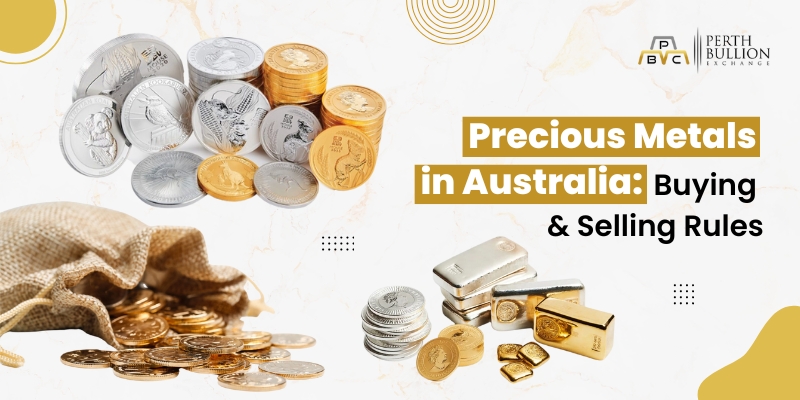Understanding the Gold-Silver Ratio: What It Means for Your Portfolio
For a long time, gold and silver have been appreciated for being beautiful and rare. Many investors pick them because they offer protection from inflation and unpredictable situations. This blog will discuss the gold-silver ratio, which explains how many ounces of silver equal one ounce of gold. By knowing this ratio, you can invest your money wisely.
What Is the Gold-Silver Ratio?
The gold-silver ratio explains the ounces of silver you must purchase to get one ounce of gold. For example, if gold costs AUD 3,000 per ounce and silver costs AUD 30 per ounce, the ratio is 100:1. Therefore, you can get 100 ounces of silver for the same price as one ounce of gold.
This ratio helps investors see which metal is worth more at the moment. If the ratio is high, silver could be less expensive than gold, leading some investors to buy silver. If the price of gold is low, it could make it a better investment. Keeping track allows you to construct a well-balanced portfolio.
What the Ratio Indicates
1. High Ratio (e.g., 80:1 or higher):
A high gold-silver ratio of 80 to 1 reflects that silver is less expensive than gold. Here, silver could be priced lower than it should be. Investors can find this a good time to purchase silver at a lower cost.
You could also swap some of your gold for silver to help diversify your assets. If one ounce of gold is AUD 2,400 and one ounce of silver is AUD 30, the ratio is 80:1, which means silver is much less expensive. If the ratio returns to normal, buying silver now could help you earn profits.
2. Low Ratio (e.g., 40:1 or lower):
Silver is priced higher than gold when the gold-silver ratio is 40 to 1 or less. This could mean that the price of silver is now too high. Some investors could sell some of their silver to secure their earnings.
It may be a good opportunity to purchase more gold, as the price of gold is lower now. A ratio of 40:1 from AUD 2,000 for gold to AUD 50 for silver means silver costs more. Making changes to your investments can guard your portfolio against sudden price drops.
How Investors Use the Gold-Silver Ratio
People use the gold-silver ratio to help them decide when to purchase or sell gold and silver. If the ratio is high, silver costs less than gold. Others choose to buy silver since they think it is not priced appropriately. Others decide to sell silver and buy gold when the ratio is low.
The ratio allows investors to change their investments and earn more profits. It also displays the ongoing trends in the value of gold and silver. Many people invest in gold to safeguard their funds during inflation or economic difficulties.
If the ratio hits a specific value, an investor could sell gold for about AUD 3,000 per ounce and buy silver at AUD 32 per ounce, hoping the price of silver will grow. This plan helps you know the best moments to buy or sell.
Pros and Cons of Using the Gold-Silver Ratio
Pros:
- Simple indicator
- Historical reliability
- Can enhance decision-making
Cons:
- Not a guaranteed predictor
- Influenced by supply/demand, geopolitics, and industrial use
- May not suit short-term traders
Impact on Portfolio Diversification
- Balances Risk: Gold and silver can behave differently when trading in the market. When the price of gold decreases, silver's cost could increase. When you hold both metals, your investment is protected from significant losses, and your risk is better spread.
- Protects Against Inflation: With more inflation, gold and silver do not lose their value. If you keep these metals in dollars, your money will likely be safer than cash, which decreases in value when inflation happens.
- Improves Stability: Mixing gold and silver makes the investment less volatile, as gold is more stable. Doing this can reduce the swings in your portfolio’s worth as time passes.
- Enhances Liquidity: In Australia, purchasing or selling gold and silver is simple. You can easily cash in your bullion for AUD when needed, which helps you keep your finances under control.
- Supports Long-Term Growth: With time, including both gold and silver in your portfolio can increase over the years. Investors can use the gold-silver ratio to decide how much of each metal to keep in their portfolio for steady, long-term results.
Practical Tips for Investors
- Watch the Gold-Silver Ratio: It tells you the ounces of silver needed to equal one ounce of gold. When silver’s price goes up, it may be less expensive than gold. Those who want to invest can purchase more silver and hold on as prices change.
- Buy from Trusted Dealers: Always choose to purchase gold and silver bullion from respected dealers in Australia. Do not be fooled by scams; you will get genuine products at fair prices in Australian dollars.
- Diversify with Other Assets: Avoid investing all your savings in gold and silver. Adding shares or property to your portfolio will make it less risky and more flexible.
- Keep Up with Market News: Keep up with updates on the gold-silver ratio and trends in the market. Relying on Australian financial news and experts in bullion helps you decide when to buy or sell.
- Consider Storage and Insurance: Once you have bought bullion, put it in a safe deposit box or a secure vault in Perth. Insurance for your metals will guard your money if stolen or lost.
Conclusion
Knowing about the gold-silver ratio can guide you to better decisions for your portfolio. When you mix gold and silver, you lower your risks and make your portfolio more stable. If you want real bullion and sound advice in Australia, contact Perth Bullion Exchange. Start preparing for your financial future by working with experts who can help you.




Comments
Post a Comment